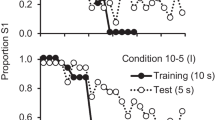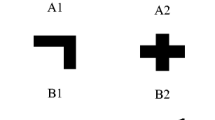Abstract
The present two experiments conducted a limited parametric study of the overtraining variable using a whole-partial reversal procedure in rats. Rats received two concurrent two-choice discriminations (Experiment 1), two concurrent go-no go successive discriminations (Experiment 2), and then received reversal training under a given condition of a whole reversal or a partial reversal either immediately after criterion training, following 2, 10, or 20 days of overtraining in Experiments 1 and 2. In Experiment 1, after 20 days of overtraining, a whole reversal, in which both discrimination tasks were reversed, produced more rapid reversal than a partial condition, in which one of the two discriminations was reversed whereas the other was maintained as in original learning. Conversely, after 2 days of overtraining rats in the partial condition reversed faster than did those in the whole condition. Experiment 2 essentially replicated results of Experiment 1. Experiments 1 and 2 show that a stimulus function transfer and stimulus substitutability, respectively, are most clearly evident after 20 days of overtraining. These results indicate that additional prereversal training (i.e., overtraining) is an obvious operational precondition for stimulus classes formation in simple concurrent discriminations in rats.
Similar content being viewed by others
References
BHATT, R. S., & WASSERMAN, E. A. (1989). Secondary generalization and categorization in pigeons. The Journal of the Experimental Analysis of Behavior, 52, 213–224.
DELI US, J. D., AMELLNG, M., LEA, S. E. G., & STADDON, J. E. R. (1995). Reinforcement concordance induces and maintains stimulus associations in pigeons. The Psychological Record, 45, 283–297.
FERSEN, L., VON, & LEA, S. E. G. (1990). Category discrimination with polymorphous feature. The Journal of the Experimental Analysis of Behavior, 54, 69–84.
GOLDIAMOND, I. (1962). Perception. In A. J. Bachrach (Ed.), Experimental foundations of clinical psychology (pp. 280–340). New York: Basic Books.
LEA, S. E. G. (1984). In what sense do pigeons learn concepts? In H. L. Roitblat, T. G. Bever, & H. S. Terrace (Eds.), Animal cognition. Hillsdale, Nj: Erlbaum.
NAKAGAWA, E. (1978). The effect of overtraining on discrimination learning in white rats (in Japanese). Japanese Journal of Psychology, 49, 70–77.
NAKAGAWA, E. (1980a). The effect of overtraining on concurrent discrimination learning in Kindergarten children (in Japanese). Japanese Journal of Educational Psychology, 28, 38–47.
NAKAGAWA, E. (1980b). Effects of the overtraining on concurrent discrimination shifts in Kindergarten children (in Japanese). Japanese Journal of Educational Psychology, 28, 114–123.
NAKAGAWA, E. (1981). Effects of amount of initial discrimination learning on subsequent discrimination shifts in young children (in Japanese). Japanese Journal of Educational Psychology, 29, 95–104.
NAKAGAWA, E. (1986). Overtraining, extinction and shift learning in a concurrent discrimination in rats. Quarterly Journal of Experimental Psychology, 38B, 213–226.
NAKAGAWA, E. (1992). Effects of overtraining on reversal learning by rats in concurrent and single discriminations. Quarterly Journal of Experimental Psychology, 44B, 37–56.
SANDERS, B. (1971). Factors affecting reversal and nonreversal shifts in rats and children. Journal of Comparative and Physiological Psychology, 74, 192–202.
VAUGHAN, W., & HERRNSTEIN, R. J. (1987). Choosing among natural stimuli. The Journal of the Experimental Analysis of Behavior, 47, 5–16.
ZENTALL, T. R., STEIRN, J. N., SHERBURNE, L. M., & URCUIOLL, P. J. (1991). Common coding in pigeons assessed through partial versus total reversals of many-to-one conditional and simple discriminations. Journal of Experimental Psychology: Animal Behavior Processes, 17, 194–201.
Author information
Authors and Affiliations
Corresponding author
Rights and permissions
About this article
Cite this article
Nakagawa, E. Stimulus Classes Formation in Concurrent Discriminations in Rats as a Function of Overtraining. Psychol Rec 48, 537–552 (1998). https://doi.org/10.1007/BF03395287
Published:
Issue Date:
DOI: https://doi.org/10.1007/BF03395287




